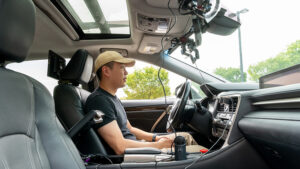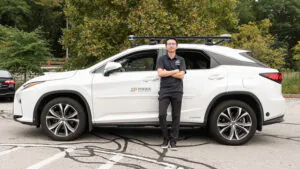As autonomous vehicles (AVs) edge closer to widespread adoption, a significant challenge remains: bridging the communication gap between human passengers and their robotic chauffeurs. While AVs have made remarkable strides in navigating complex road environments, they often struggle to interpret the nuanced, natural language commands that come so easily to human drivers.
Enter an innovative study from Purdue University’s Lyles School of Civil and Construction Engineering. Led by Assistant Professor Ziran Wang, a team of engineers has pioneered an innovative approach to enhance AV-human interaction using artificial intelligence. Their solution is to integrate large language models (LLMs) like ChatGPT into autonomous driving systems.’
The Power of Natural Language in AVs
LLMs represent a leap forward in AI’s ability to understand and generate human-like text. These sophisticated AI systems are trained on vast amounts of textual data, allowing them to grasp context, nuance, and implied meaning in ways that traditional programmed responses cannot.
In the context of autonomous vehicles, LLMs offer a transformative capability. Unlike conventional AV interfaces that rely on specific voice commands or button inputs, LLMs can interpret a wide range of natural language instructions. This means passengers can communicate with their vehicles in much the same way they would with a human driver.
The enhancement in AV communication capabilities is significant. Imagine telling your car, “I’m running late,” and having it automatically calculate the most efficient route, adjusting its driving style to safely minimize travel time. Or consider the ability to say, “I’m feeling a bit carsick,” prompting the vehicle to adjust its motion profile for a smoother ride. These nuanced interactions, which human drivers intuitively understand, become possible for AVs through the integration of LLMs.
Purdue University assistant professor Ziran Wang stands next to a test autonomous vehicle that he and his students equipped to interpret commands from passengers using ChatGPT or other large language models. (Purdue University photo/John Underwood)
The Purdue Study: Methodology and Findings
To test the potential of LLMs in autonomous vehicles, the Purdue team conducted a series of experiments using a level four autonomous vehicle – just one step away from full autonomy as defined by SAE International.
The researchers began by training ChatGPT to respond to a range of commands, from direct instructions like “Please drive faster” to more indirect requests such as “I feel a bit motion sick right now.” They then integrated this trained model with the vehicle’s existing systems, allowing it to consider factors like traffic rules, road conditions, weather, and sensor data when interpreting commands.
The experimental setup was rigorous. Most tests were conducted at a proving ground in Columbus, Indiana – a former airport runway that allowed for safe high-speed testing. Additional parking tests were performed in the lot of Purdue’s Ross-Ade Stadium. Throughout the experiments, the LLM-assisted AV responded to both pre-learned and novel commands from passengers.
The results were promising. Participants reported significantly lower rates of discomfort compared to typical experiences in level four AVs without LLM assistance. The vehicle consistently outperformed baseline safety and comfort metrics, even when responding to commands it hadn’t been explicitly trained on.
Perhaps most impressively, the system demonstrated an ability to learn and adapt to individual passenger preferences over the course of a ride, showcasing the potential for truly personalized autonomous transportation.

Purdue PhD student Can Cui sits for a ride in the test autonomous vehicle. A microphone in the console picks up his commands, which large language models in the cloud interpret. The vehicle drives according to instructions generated from the large language models. (Purdue University photo/John Underwood)
Implications for the Future of Transportation
For users, the benefits are manifold. The ability to communicate naturally with an AV reduces the learning curve associated with new technology, making autonomous vehicles more accessible to a broader range of people, including those who might be intimidated by complex interfaces. Moreover, the personalization capabilities demonstrated in the Purdue study suggest a future where AVs can adapt to individual preferences, providing a tailored experience for each passenger.
This improved interaction could also enhance safety. By better understanding passenger intent and state – such as recognizing when someone is in a hurry or feeling unwell – AVs can adjust their driving behavior accordingly, potentially reducing accidents caused by miscommunication or passenger discomfort.
From an industry perspective, this technology could be a key differentiator in the competitive AV market. Manufacturers who can offer a more intuitive and responsive user experience may gain a significant edge.
Challenges and Future Directions
Despite the promising results, several challenges remain before LLM-integrated AVs become a reality on public roads. One key issue is processing time. The current system averages 1.6 seconds to interpret and respond to a command – acceptable for non-critical scenarios but potentially problematic in situations requiring rapid responses.
Another significant concern is the potential for LLMs to “hallucinate” or misinterpret commands. While the study incorporated safety mechanisms to mitigate this risk, addressing this issue comprehensively is crucial for real-world implementation.
Looking ahead, Wang’s team is exploring several avenues for further research. They’re evaluating other LLMs, including Google’s Gemini and Meta’s Llama AI assistants, to compare performance. Preliminary results suggest ChatGPT currently outperforms others in safety and efficiency metrics, though published findings are forthcoming.
An intriguing future direction is the potential for inter-vehicle communication using LLMs. This could enable more sophisticated traffic management, such as AVs negotiating right-of-way at intersections.
Additionally, the team is embarking on a project to study large vision models – AI systems trained on images rather than text – to help AVs navigate extreme winter weather conditions common in the Midwest. This research, supported by the Center for Connected and Automated Transportation, could further enhance the adaptability and safety of autonomous vehicles.
The Bottom Line
Purdue University’s groundbreaking research into integrating large language models with autonomous vehicles marks a pivotal moment in transportation technology. By enabling more intuitive and responsive human-AV interaction, this innovation addresses a critical challenge in AV adoption. While obstacles like processing speed and potential misinterpretations remain, the study’s promising results pave the way for a future where communicating with our vehicles could be as natural as conversing with a human driver. As this technology evolves, it has the potential to revolutionize not just how we travel, but how we perceive and interact with artificial intelligence in our daily lives.


Credit: Source link




